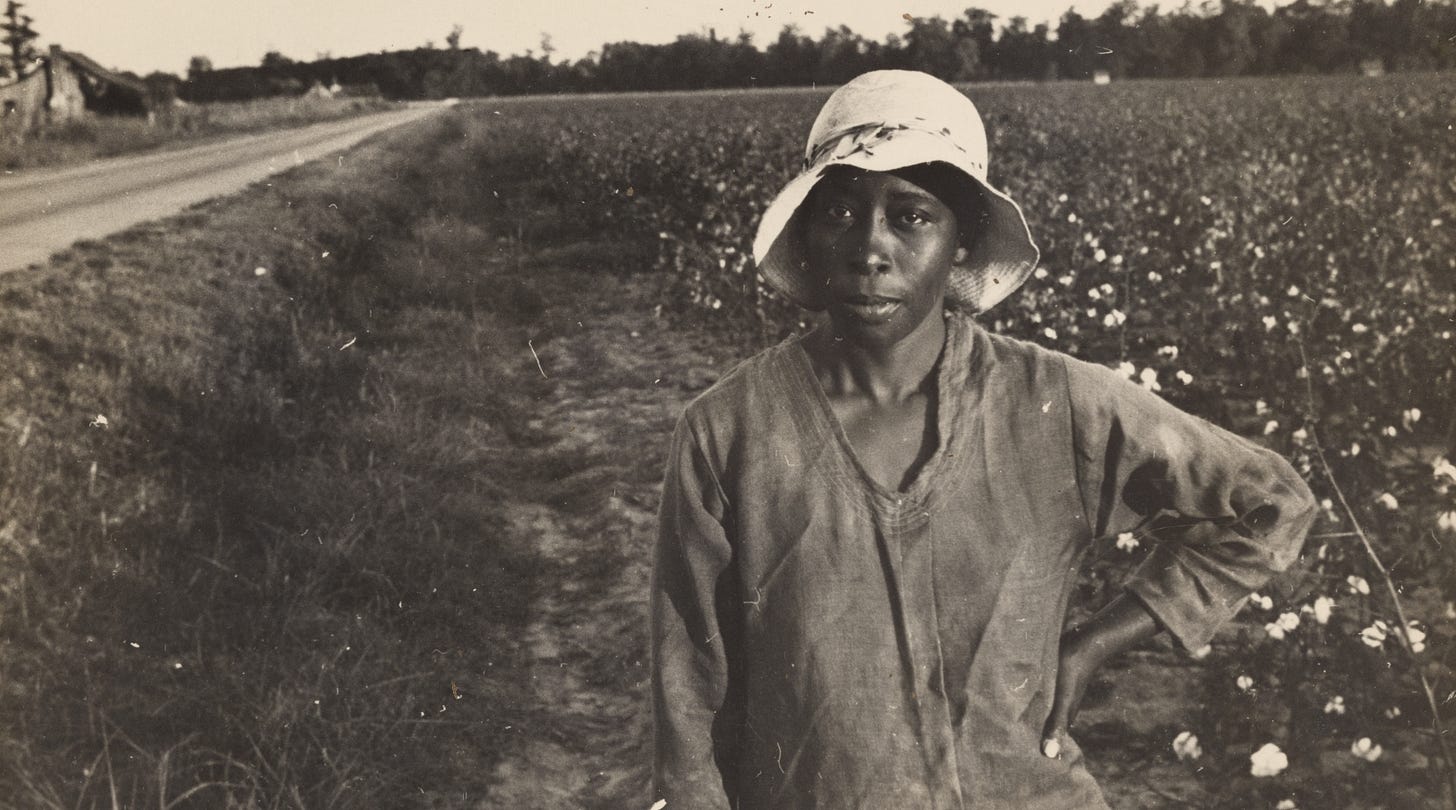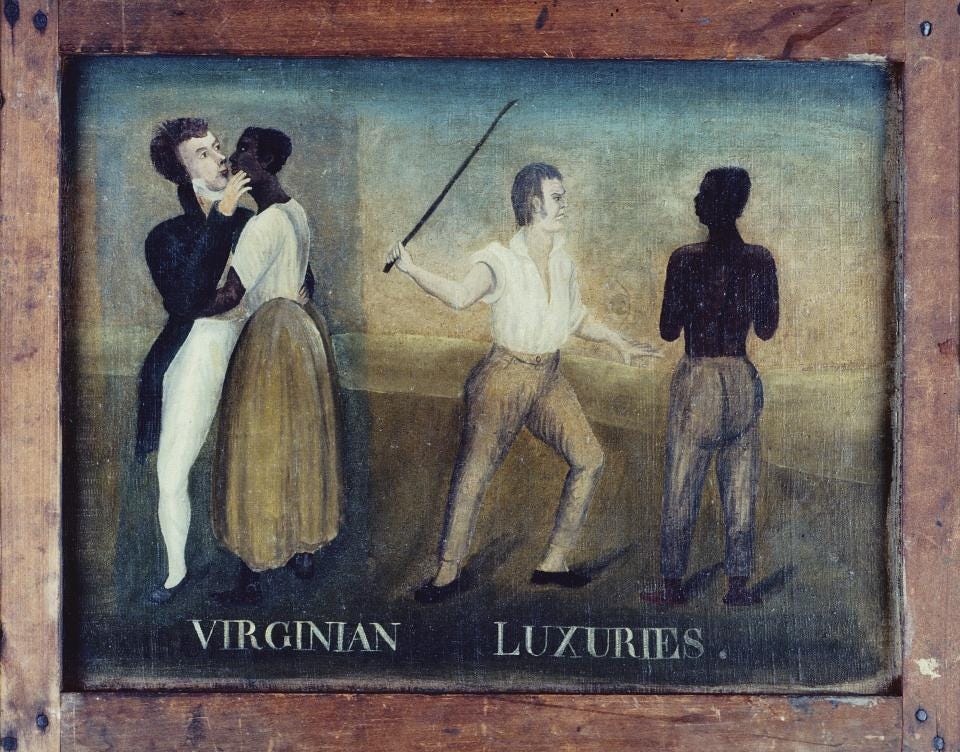How Black Americans Were Re-enslaved after Juneteenth
A cautionary tale about one of the most disgraceful chapters in American history.

Click below for audio
As we celebrate Juneteenth for the third time since it became a national holiday in 2021, let’s take a moment to consider the young field worker in the picture above.
She looks like she might be an enslaved person from the years before the Emancipation Proclamation. But this photo was taken in 1935 in Pulaski County, Arkansas. That’s 70 years after June 19, 1865 — the first Juneteenth — when Major General Gordon Granger arrived on the island of Galveston, Texas, and read General Order №3, which announced that slavery was over.
Seventy years!
So how come a field worker in 1935 appears to be in the same situation as her antebellum ancestors? What happened to the promise of Juneteenth? How did African Americans blow their freedom and wind up basically re-enslaved until the Civil Rights movement of the 1960s nearly a century later?
Short answer? They didn’t blow it. They got railroaded
The promise of Juneteenth was undercut by a sustained and often coordinated campaign historians call “The Redemption.” Not the one celebrated at Easter. This redemption called for the return of white supremacy and the removal of rights for African Americans.
Don’t be surprised if you never heard about this in school. That was part of the plan.
I’m not making this up.
For research on a novel I’m writing, I recently read Stony the Road, a history of the post-Reconstruction period by Henry Louis Gates, Jr. What I learned from the book and its 4-hour PBS companion series provided shocking answers to the questions I raised above.
But this history is also a cautionary tale for the present. One that should not be forgotten as we celebrate this year’s Juneteenth national holiday. Think of it. By the time the Civil War ended in 1865, nearly 4 million African Americans were still imprisoned in forced-labor concentration camps (also known as plantations), which dated as far back as 1619.
Once you were stolen from Africa and sold into the “peculiar institution,” you remained there for life, and so did your children. So it’s not too difficult to imagine the exhilaration and promise that came with freedom.
They did their best to make the most of it.
The progress of African Americans in the 12 years between the end of the Civil War in 1865 and the end Reconstruction in 1877 was astonishing.
Sixteen Black Americans served in Congress. Six hundred were elected to state legislatures, and hundreds more held local offices across the South. Many of these Black officeholders came from the educated class of free Black people.
They included well-spoken and politically astute attorneys, businessmen, and landowners like Joseph Rainey of South Carolina, Hiram Rhodes Revels of Mississippi, Benjamin Turner of Alabama, George Henry White of North Carolina, and many more. Keep that in mind — because it’s been covered up and replaced with a lie.
Freedmen’s Bureau
In March of 1865, Congress created the Freedmen’s Bureau to help millions of formerly enslaved Black people and poor whites after the Civil War. The bureau’s mandate was to provide “provisions, clothing, fuel, and immediate temporary shelter for destitute and suffering white refugees as well as the freedmen, their wives, and their children.”
But the Freedmen’s Bureau was underfunded and understaffed. Congress provided no money for it, so it was placed under the War Department. At its peak, the Bureau employed only 900 agents to handle the needs of four million Black people and thousands of poor whites displaced by the war.
Nevertheless, by the end of 1865, the Freedmen’s Bureau had spent $5 million to set up schools, and about 90 thousand freedman were enrolled as students. Within 5 years, the bureau had established more than a thousand schools for formerly enslaved African Americans, whose forced labor had produced 75 percent of the world’s cotton.
The Freedmen’s Bureau also established Howard, Fisk, and Hampton Universities. It even tried, with less success, to ensure that freedmen were given property seized during the war.
So what happened to change things?
As early as 1873, eight years after Juneteenth, white supremacists in the South began calling for The Redemption.
Their idea of this word had nothing to do with the salvation of souls. It was all about “redeeming” the South itself. Bringing the “fallen states of the Confederacy” back into the Union — and restoring the Southern way of life.
This meant getting rid of Reconstruction and any programs intended to put African Americans on an equal footing with whites. Their relentless efforts to achieve this lasted decades.
Here’s how they got away with it.
Two days after the Confederate surrender at Appomattox, Abraham Lincoln appeared on the balcony of the White House and made an impromptu speech, stating that he believed African Americans should be allowed to vote.
Upon hearing this, John Wilkes Booth said that’s the last speech he will ever give. Three days later, on April 14th, 1865, Booth shot the President in the head while he was watching a comedy called Our American Cousin at the Ford Theater.
Andrew Johnson
Within a year of Lincoln’s death, his successor Andrew Johnson appointed former Confederate secessionists as provisional governors of the Southern states. They soon passed restrictive Black Codes, which introduced vagrancy laws and forced African Americans into binding annual contracts as sharecroppers.
If you didn’t have a job, you were convicted of vagrancy and sent to prison, where you were then hired out to pick cotton or work in factories under the convict leasing system.
Despite fierce opposition from Congress and his eventual impeachment, Johnson’s presidency ushered in the beginning of the end of Reconstruction. And the virtual re-enslavement of African Americans.
Here are 11 other mind-blowing assaults on Black freedom.
White Supremacists regained power in Congress after the Panic of 1873 led to the fall of Lincoln’s Republican party.
In 1883, the Supreme Court overturned the landmark 1875 Civil Rights Act, which “guaranteed all citizens — regardless of color — equal access to accommodations, theaters, public schools, churches, and cemeteries.”
The stalemate following the presidential election of 1876 led to the Compromise of 1877, in which Southerners agreed to put Rutherford B. Hayes in the White House in exchange for the removal of federal oversight and troops from the former Confederate states. This nailed shut the coffin on Reconstruction and all its progressive programs.
Southern states prevented Black American from voting by rewriting their constitutions with language that did not appear to violate the 14th Amendment. Instead of using race to disqualify, they required literacy tests, poll taxes, and proof you understood the constitution.
White supremacists routinely lynched nearly 5 thousand African Americans in a sustained reign of terror, often over false claims that Black men had assaulted white women.
In 1896, the Supreme Court legalized segregation. In Plessy v. Ferguson it ruled that separate-but-equal did not violate the 14th Amendment. This decision would stand 58 years until 1954.
Thousands of racist memes saturated popular culture through newly developed mass-printing techniques. An unprecedented number of cartoons, magazines, and product advertising depicted African Americans as negative stereotypes. The mammy. The zip coon. The dangerous predator. And the stupid bumbling Negro character Jim Crow.
Refusing to be governed by Black officeholders, white supremacists took control of state legislatures. In an incident reminiscent of the January 6th Attack on the Capitol, an armed mob in Wilmington, NC, overthrew the government and physically removed duly elected Black officials from office.
The Redemption rewrote the narrative of the Civil War and of Reconstruction. The latter was falsely portrayed as a federally enforced attempt to make the white man subservient to the Black man. Based on Edward Pollard’s book The Lost Cause, the new narrative claimed that the intentions of the Confederacy were admirable and righteous despite military defeat. It falsely claimed that Black Reconstruction legislators were ignorant, venal or predatory. And that Jim Crow laws were necessary because Black people were “inferior.”
The United Daughters of the Confederacy emerged as a powerful group and spent decades reshaping textbooks to reflect the Lost Cause perspective. It pushed publishers to reject any book that claimed the South fought the war to keep slavery. Or depicted slaveholders as cruel and unjust. Ignoring rape, torture, and exploitation, new textbooks had to claim that enslaved people were happy, prosperous, and joyful folk who had everything provided for them.
As if all that were not bad enough, President Woodrow Wilson screened The Birth of a Nation at the White House in 1915, lending credibility to the film’s racist themes. The movie reinforced the beliefs and philosophies of The Redemption and justified the rise of the Ku Klux Klan. It was wildly popular throughout the country, convincing audiences everywhere that its lies were true.
Is this past also prophecy?
You don’t have to be a historian to see the parallels between that dehumanizing history and the rise of white supremacist ideologies in the present. What history reveals is that these people will not stop.
Since 2021, 44 states have taken steps to limit the teaching of racism, sexism, and critical race theory. As a result of the many false claims of voter fraud following the 2020 election, at least 27 states have taken measures to restrict voting.
But we are making progress.
In order to fully enjoy and appreciate this year’s Juneteenth, we must understand and remember how freedom was taken away. In the words of the old Civil Rights song, Freedom is a constant struggle.
To recognize Juneteenth officially after 156 years of piecemeal celebrations and the sad history noted above is to acknowledge that African American history is also American History.
That is why I believe the two weeks between June 19th and July 4th should be a continuous celebration similar to the end-of-year holidays. Both dates are linked by the nation’s commitment to freedom and democracy. They reflect the same principle.
Now, with strong evidence of autocracy rising elsewhere on the planet, what could be more relevant or important than a sustained 2-week period of reflection on the freedom we enjoy as Americans. A time when we acknowledge the truth about our history and renew our commitment to the foundational principles that make us a beacon of hope for the rest of the world.
Happy Juneteenth! Enjoy your holiday. And let freedom ring!
©2023 Andrew Jazprose Hill
Thanks for reading.





It's shocking how similar the modern right's "talking points" are to the propaganda of the Redemption era. This underscores the importance of fighting the resurgence of the supremacists today,, and especially the urgency of defeating the censors of history. Our past is disturbing; all the more reason to not bury it.
Astounding and insightful, the American story is one of discovery and disturbing truth